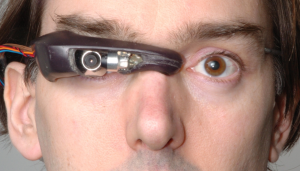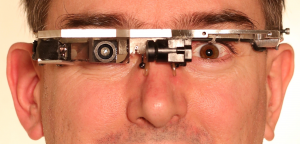EyeTap
EyeTap is a small camera attached to glasses-like frame that records everything the user sees and then it immediately displays the recorded information into the user’s eyes. The difference to a regular camera is that EyeTap has the ability to inject the displayed message with virtual elements, essentially making the whole device function as an augmented reality device. The inventor of this device calls this process ‘mediating the reality.’[1][2]
Contents
Main characteristics
The device consists of an eyepiece attached to a frame and a processing unit that is connected to the head-mounted part with a cable. In order to display the digital information on top of what the user actually sees, the eyepiece uses a beam splitter, that partially allows the visual information to pass through and into the user’s eye, while reflecting part of the image into the digital camera mounted on the nose-bridge. The connected computer processes the information, adds a layer of virtual elements, and then sends the augmented image to a projector in the eyepiece. The user then sees a combination of a superimposed augmented image and the original scene.[3]
By the opinion of the device’s inventors, EyeTap differs from other head-mounted displays or augmented reality glasses in that it superimposes the virtual information onto the original image in such a way, that original elements may become completely occluded without any mismatches. [4] This contrasts with the usual approach of other systems that do not have the ability to completely block out the elements in the original scene. In EyeTap, this can be used to reduce unwanted elements from the user’s surroundings, such as advertisement. The always present camera on user’s head can also work as a tool for Sousveillance (see Ethical Issues).
Steve Mann began designing and inventing early versions of EyeTap in the 1970s. The first iterations were bulky. They used big CRT projectors that were not yet comfortable to wear for a time longer than a few hours at most. Thanks to the advances in used technologies, he was able to miniaturized his invention and in 1995, created a device that was built around a normal glasses frame.
This was further miniaturized and in 2000, Steve Mann created EyeTap that closely resembles today’s iteration. The development did not stop at this point, though. Mann is currently experimenting with a prototype that has its camera and projector behind the user’s head and the visual information is transmitted through an fiber optic cable attached to eyeglasses lenses on a frame that holds the lenses in the middle rather than at the top. This is done so the fiber optic cable sits in front of the user’s eye and according to Mann, the frame itself is almost invisible due to it being rather thin and close to the eyes.[3]
Purpose
Communication device, visual and memory aid/prosthetic, lifelong capture and sharing of audio-visual memories (‘Cyborglogging’), sharing mediated reality, art. [5]
Company & People
Steve Mann - Inventor, professor at the University of Toronto, director of ePI Lab. Mann is recognized as the “father of wearable computer” and as a founder of wearable computing as a new discipline. [6] He is an author of the book CYBORG: Digital Destiny and Human Possibility in the Age of the Wearable Computer.
EyeTap Personal Imaging Lab (or ePI Lab) was founded in 1998 at the University of Toronto by Steve Mann. Its research encompasses wearable computers, personal imagining, mediated reality and existential technology. The lab’s ultimate goal is to develop a new generation of personal imagining interfaces.
Important Dates
- Research into devices similar to this one begun in 1979. [7]
- Iteration resembling today’s iteration was developed in 2000. [8]
- Not available for public.
Ethical Issues
Steve Mann was allegedly assaulted in Paris in 2012 while he was wearing an EyeTap device. [9] This is not a one time occurrence, Mann was assaulted in the past before. [10]
Health Risks
Mann himself mentions adverse effects on his cognitive abilities when he removes the device. [11][10]
Enhancement/Therapy/Treatment
Enhancement and therapy as well. The device not only acts to enhance user’s vision but it can also serve as a form of visual, or rather, memory aid to recognize people the user may know and display information about them in his visual field (e.g. floating text with the name of the person) [12] It can also help visually impaired people. In 2009, Mann’s system was successfully implanted on a visually impaired man. [13]
Public & Media Impact and Presentation
With the media focused on the current wearables being manufactured by large companies such as Google Glass or Facebook’s Oculus Rift, EyeTap is not overly represented in the media. Apart from local Toronto news [14], EyeTap seems to be drowned by the hype formed around the other devices. Although, various news sources does sometimes mention Steve Mann while discussing the history of wearable technology. [15]
Public Policy
Related Technologies, Project or Scientific Research
References
- ↑ BERGSTEIN, Brian. Professor's 25 years of cyborg life mirrors tech advances. USA Today [online]. 2004, Jan 12. Available online at: http://usatoday30.usatoday.com/tech/news/2004-01-12-steve-mann_x.htm (Retrieved Jul 27, 2015)
- ↑ MANN, Steve. Computer mediated reality. Random disorganized thoughts on WearComp.org, WearCam.org, EyeTap Digital Eye Glass, funtain and Steve Mann's Personal Web Page/research [online]. 1998, Jan 6. Available online at: http://n1nlf-1.eecg.toronto.edu/historical/node12.html#SECTION00042000000000000000 (Retrieved Jul 27, 2015)
- ↑ 3.0 3.1 MANN, Steve. Continuous lifelong capture of personal experience with EyeTap. In: Proceedings of the the 1st ACM workshop on Continuous archival and retrieval of personal experiences. ACM, 2004. p. 1-21.


